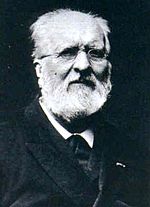Gabriel de Mortillet facts for kids
Quick facts for kids
Louis Laurent Gabriel de Mortillet
|
|
|---|---|

Louis Laurent Gabriel de Mortillet
|
|
| Born | 29 August 1821 Meylan, Isère
|
| Died | 25 September 1898 (aged 77) |
| Nationality | French |
| Scientific career | |
| Fields | anthropology |
Louis Laurent Gabriel de Mortillet (born August 29, 1821 – died September 25, 1898) was a French archaeologist and anthropologist. He was born in Meylan, a town in France.
Contents
About Louis de Mortillet
Louis de Mortillet went to school at the Jesuit college in Chambéry. He also studied at the Paris Conservatoire. In 1847, he became the owner of a magazine called La Revue indépendante.
He was involved in the Revolution of 1848, a big political change in France. Because of this, he was sentenced to two years in prison. He left France and lived in other countries for about 15 years, mostly in Italy.
In 1858, he started studying ethnology. This is the study of different human groups and cultures. He focused on ancient homes built on lakes in Switzerland, called lake-dwellings. He also wrote about early humans in Northern Italy. His third book connected these early humans to the Ice Age, a time when much of Earth was covered in ice.
He returned to Paris in 1863. Soon after, he became a curator at the new Musée des Antiquités Nationales. A curator is someone who takes care of museum collections. He was in charge of items from the Stone Age. Later, he became the mayor of Saint-Germain-en-Laye. In 1885, he was elected as a deputy, which means he was a representative for his area.
He also started a magazine called Matériaux pour l'histoire positive et philosophique de l'homme. He helped create the French School of Anthropology with Paul Broca. This school was a place for studying humans and their cultures. Louis de Mortillet passed away in St Germain-en-Laye on September 25, 1898.
How Mortillet Classified the Stone Age
Louis de Mortillet is famous for making the Paleolithic (Old Stone Age) clearer. Another scientist, Édouard Lartet, had used animals like mammoths or reindeer to tell different periods apart. But Mortillet realized that animals change depending on the area. This made them unreliable for classifying time periods.
Instead, Mortillet first suggested classifying periods by where people lived. For example, he used "Alluvial" (river-related) or "Cave" periods. He later found this system also had problems. In 1869, he created a new way to classify periods. He used specific places, called type sites, and the tools or items found there. These items are called artifacts.
He named periods after these sites, like Chellian, Mousterian, Solutrean, and Magdalenian. His system has been improved over time, but it is still used today. Mortillet believed these classifications were universal stages. He thought all cultures developed in the same way, one after another (this is called unilineal evolution). However, later scientists think cultures are more local. They can overlap in time and don't always follow a single path.
Mortillet also suggested the name "Marnian Epoch." This was for a period usually called the Gallic period. It lasted from about 500 years before Christ until Gaul (ancient France) was conquered by Julius Caesar. Mortillet didn't like the term "Gallic." He felt the culture of that time was not just in Gaul. It was common across much of Europe. The name "Marnian" comes from a French area called Marne.
Stone Age Art Discoveries
De Mortillet understood how important the small, portable art objects were. These are called mobiliary art. They were found by Lartet and Christie. He said about these bone carvings, "They are not the work of children. They are the childhood of art." This means they were early forms of art.
However, he found it hard to believe that the much larger cave art was real. Cave art refers to paintings found on cave walls. He strongly rejected the discovery of paintings in the Cave of Altamira by Marcelino Sanz de Sautuola. Mortillet did not believe these paintings were made by palaeolithic man (early humans from the Stone Age).
Published Works
- Promenades au Musée de Saint-Germain (1869)
- Classification des diverses périodes de l'âge de la pierre (1873)
- Musée préhistorique (1881)
- Le préhistorique, antiquité de l'homme (1882)
- Les Nègres et la civilisation égyptienne (1884)
- Origines de la chasse, de la pêche et de l'agriculture (1890)
- Le préhistoire : origine et antiquité de l'homme (1900)
See also
 In Spanish: Gabriel de Mortillet para niños
In Spanish: Gabriel de Mortillet para niños
- Henry Christie

